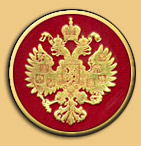 The
Romanov family ruled Russia from 1613 to 1855 and during this
time, Russia became a major European power. The first rulers
of this dynasty struggled to end internal disorder, foreign
invasion and financial collapse. The
Romanov family ruled Russia from 1613 to 1855 and during this
time, Russia became a major European power. The first rulers
of this dynasty struggled to end internal disorder, foreign
invasion and financial collapse.
For the first few generations, the Romanovs were happy
to maintain the statusquo in Russia. They continued to centralize
power, but they did very little to bring Russia up to speed
with the rapid changes in economic and political life that were
taking place elsewhere in Europe. Peter the Great decided to
change all of that.
|
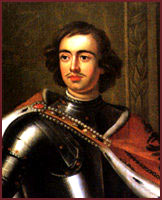 Peter
I "the Great", Romanov (1672 - 1725) was proclaimed
Tzar at the age of 10, but due to a power struggle had to
rule under the patronage of his sister Sofia. He seized control
from her when he was just 17. Peter
I "the Great", Romanov (1672 - 1725) was proclaimed
Tzar at the age of 10, but due to a power struggle had to
rule under the patronage of his sister Sofia. He seized control
from her when he was just 17.
Peter was his father's youngest son and the child of
his second wife, neither of which promised great things.
Tsar Alexis, his father, also had three children by his
first wife: Feodor, Sophia and Ivan, a semi-imbecile. When Alexis
died in 1676 Feodor became Tsar, but his poor constitution brought
an early death in 1682. The family of Peter's mother succeeded
in having him chosen over Ivan to be Tsar, and the ten year-old
boy was brought from his childhood home at the country estate
of Kolomenskoe to the Kremlin.
No sooner was he established, however, than the Ivan's family
struck back. Gaining the support of the Kremlin Guard, they
launched a coup d'etat, and Peter was forced to endure the horrible
sight of his supporters and family members being thrown from
the top of the grand Red Stair of the Faceted Palace onto the
raised pikes of the Guard. The outcome of the coup was a joint
Tsar-ship, with both Peter and Ivan placed under the regency
of Ivan's elder and not exactly impartial sister Sophia. Peter
had not enjoyed his stay in Moscow, a city he would dislike
for the rest of his life.
|
|
 With
Sophia in control, Peter was sent back to Kolomenskoe.
It was soon noticed that he possessed a penchant for war games,
including especially military drill and siegecraft. He became
acquainted with a small community of European soldiers, from
whom he learned Western European tactics and strategy. Remarkably,
neither Sophia nor the Kremlin Guard found this suggestive.
In 1689, just as Peter was to come of age, Sophia attempted
another coup--this time, however, she was defeated and confined
to Novodevichiy Convent. Six
years later Ivan died, leaving Peter in sole possession of
the throne. With
Sophia in control, Peter was sent back to Kolomenskoe.
It was soon noticed that he possessed a penchant for war games,
including especially military drill and siegecraft. He became
acquainted with a small community of European soldiers, from
whom he learned Western European tactics and strategy. Remarkably,
neither Sophia nor the Kremlin Guard found this suggestive.
In 1689, just as Peter was to come of age, Sophia attempted
another coup--this time, however, she was defeated and confined
to Novodevichiy Convent. Six
years later Ivan died, leaving Peter in sole possession of
the throne.
Rather than taking up residence and rule in Moscow,
his response was to embark on a Grand Tour of Europe. He amassed
a considerable body of knowledge on western European industrial
techniques and state administration, and became determined
to modernize the Russian state and to westernize its society.
He spent about two years there, not only meeting monarchs
and conducting diplomacy but also travelling incognito and
even working as a ship's carpenter in Holland.
Peter believed in starting from the bottom and working
his way up. He learned ship building from the Europeans he
invited to Russia, and built a ship himself. In 1697, he accompanied
an embassy to European courts as a carpenter named Peter Mikhailov.
He also served as seaman, soldier, barber and, to the discomfort
of his courtiers, as dentist.. Those of his companions
who fell ill and needed a doctor were filled with terror that
the Tsar will hear of their illness and appear with his instruments
to offer his services.
In 1698, still on tour, Peter received news of yet
another rebellion by the Kremlin Guard, instigated by Sophia
despite her confinement to Novodevichiy.
He returned without any sense of humor, decisively defeating
the guard with his own European-drilled units, ordering a
mass execution of the surviving rebels, and then hanging the
bodies outside Sophia's convent window. She apparently went
mad. The following day Peter began his program to recreate
Russia in the image of Western Europe by personally clipping
off the beards of his nobles. He even taxed Russians wearing
beards!!!
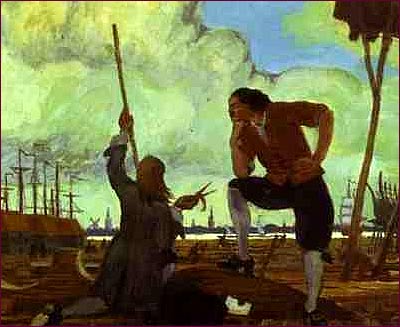
Mstislav Dobuzhinsky. Peter the
Great in Holland. Amsterdam, the Wharf of the East India Company.
Sketch. 1910. Oil on paper mounted on cardbord. The Tretyakov
Gallery, Moscow.
|
Peter's return to Russia and assumption
of personal rule hit the country like a hurricane.
He banned traditional Muscovite dress for all men, introduced
military conscription, established technical schools, replaced
the church patriarchy with a holy synod answerable to himself,
simplified the alphabet, tried to improve the manners of the
court, changed the calendar, changed his title from Tsar to
Emperor, and introduced a hundred other reforms, restrictions,
and novelties (all of which convinced the conservative clergy
that he was the antichrist).
In 1703 he embarked on the most dramatic of his reforms
- the decision to transfer the capital from Moscow to a new
city to be built from scratch on the Gulf of Finland. Over the
next nine years, at tremendous human and material cost, St.
Petersburg was created.
|
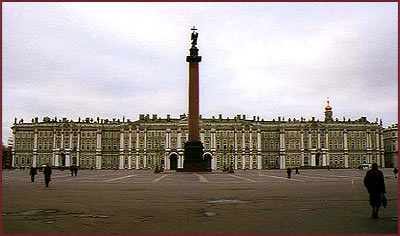 |
From the 1760s the Winter
Palace was the main residence of the Russian Tzars.
Peter also required all men to serve the state. Further
changes included abolishing hereditary positions with the creation
of the Table of Ranks that gave people privileges based on their
ability and position within the Table of Ranks. Along with changes
to the church, Peter increased the education that Russians received.
He created the first universities in Russia. Peter sent Russians
to be educated in the West, and imported skilled labour, military
and administrative experts from abroad. He encouraged smoking,
but taxed tobacco.

Perhaps the most important step that Peter took to ensure
the continuation of Western influence in Russia was to introduce
the practice of marrying royal princes to Western princesses.
Thereafter, nearly every tsar had a German wife, and
thus the German influence became strong in upper-class circles.
Peter himself had been married to the daughter of a Russian
nobleman in his youth in accordance with the earlier practice,
but he put her in a convent soon after he began to govern personally.
Perhaps realizing that under the circumstances he could not
hope to find a suitable Western princess for himself, he eventually
married his mistress Martha Scavronsky (later changed name to
Catherine).
|
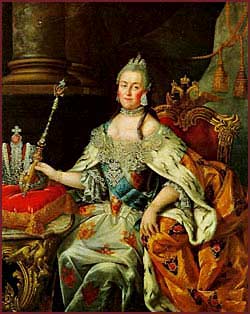 A
servant girl, Martha Scavronsky, made a great career in the
Russian court. In her native Lithuania during the war she was
taken by the Russian soldier. Then she caught the eye of Prince
Boris Sheremetyev, who purchased her for one ruble and made
her one of his many mistresses. Prince Alexander
Menshikov, tsar's favorite 'borrowed' her for himself. Peter
I saw Martha in Menshikov's house and ordered, "When
I go to bed, you, beauty, take a candle and light the way."
According to the "etiquette" that meant
she was obliged to sleep with the tsar. In the morning Peter
paid her with a copper coin. Peter had granted himself this
modest sum for love expenses when still a young man and all
his life he strictly followed the tariff. Later, though, the
tsar married Martha and she became Catherine I, Empress of Russia.
She gave Peter three children and proved a fit companion for
the restless monarch. A
servant girl, Martha Scavronsky, made a great career in the
Russian court. In her native Lithuania during the war she was
taken by the Russian soldier. Then she caught the eye of Prince
Boris Sheremetyev, who purchased her for one ruble and made
her one of his many mistresses. Prince Alexander
Menshikov, tsar's favorite 'borrowed' her for himself. Peter
I saw Martha in Menshikov's house and ordered, "When
I go to bed, you, beauty, take a candle and light the way."
According to the "etiquette" that meant
she was obliged to sleep with the tsar. In the morning Peter
paid her with a copper coin. Peter had granted himself this
modest sum for love expenses when still a young man and all
his life he strictly followed the tariff. Later, though, the
tsar married Martha and she became Catherine I, Empress of Russia.
She gave Peter three children and proved a fit companion for
the restless monarch. |

|
|
Interesting Episode
The Frenchman Vilbois was Peter's favorite and aide-de-camp.
He was a drunkard, brawler and womanizer. Once Peter sent
this officer with an errand to his wife Catherine from St.
Petersburg to Kronstadt, where the tsarina lived in winter.
While traveling, Vilbois drank a bottle of vodka and came
to the place absolutely drunk. The ladies-in-waiting refused
to admit him to tsarina, saying that Her Majesty was sleeping.
“Wake her up immediately!” roared the officer. The
frightened ladies brought him to the tsarina’s bedroom
and left him before her bed for him to wake her up himself.
The drunk officer was so excited by the sleeping woman that
he completely forgot she was the tsarina. Catherine cried
for help, but unfortunately it came too late.
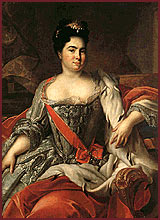 The
most interesting part in the story is the reaction of Peter. The
most interesting part in the story is the reaction of Peter.
The tsar grinned and said, ‘Vilbois, the brute, was drunk
and did not understand what he was doing. I bet, when he is
sober he'll not remember anything.” Peter sentenced the
Frenchman for exile for 2 years. However he returned him in
a couple of months with the following excuse: “benefits
from his knowledge and experience considerably exceed the
damage he had caused.”
Peter could excuse “accidents”, but never
deliberate unfaithfulness. When Peter found that William
Mons became Catherine's lover, he had the man beheaded.
Then he ordered the head of the unfortunate lover to be put
in a jar with alcohol. The jar stood in Catherine's bedroom
till Peter's death.

|
|
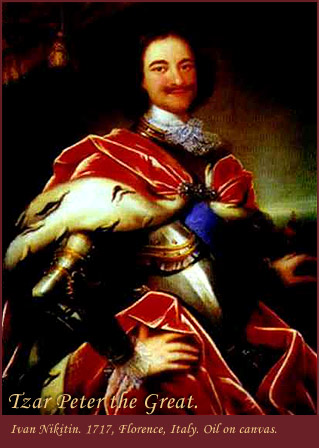
|

|
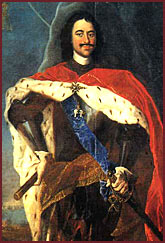 Peter
was free and easy in his relationship with people, but his social
manners were a mixture of the habits of a powerful aristocrat
and those of an artisan. Whenever he went visiting he would
sit down in the first vacant seat, if he was hot he would take
off his shirt in front of everybody. It was this habit of dispensing
with knives and forks at table that had so shocked the princesses
of Germany. He had no manners whatsoever and did hot consider
them necessary. Peter
was free and easy in his relationship with people, but his social
manners were a mixture of the habits of a powerful aristocrat
and those of an artisan. Whenever he went visiting he would
sit down in the first vacant seat, if he was hot he would take
off his shirt in front of everybody. It was this habit of dispensing
with knives and forks at table that had so shocked the princesses
of Germany. He had no manners whatsoever and did hot consider
them necessary.
Physically Peter was a giant of just under seven feet, and
at any gathering he towered a full head above everybody else.
Not only was Peter a natural athlete, but habitual use of ax
and hammer had developed his strength and 'manual dexterity
to such an extent that he was able to twist a silver platter
into a scroll.
Peter had other sides to his character. He spent time
and money generously in obtaining paintings and statues from
Italy and Germany which formed the foundations for the Hermitage
Collection at St. Petersburg.
The many pleasure palaces which he had built round his new capital
indicate his taste in architecture. At enormous cost he hired
the best European architects.
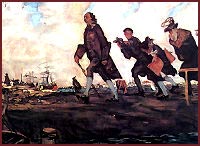 Peter
was never more than a guest in his own home. During his reign
he had traveled the length of Russia. He was also the first
Russian ruler to travel outside of Russia. As a result of
this perpetual mobility, Peter became so restless that he was
constitutionally incapable of staying in one place for any length
of time. He had such a long stride and used to walk so quickly
that his companions had to run to keep up with him. Peter
was never more than a guest in his own home. During his reign
he had traveled the length of Russia. He was also the first
Russian ruler to travel outside of Russia. As a result of
this perpetual mobility, Peter became so restless that he was
constitutionally incapable of staying in one place for any length
of time. He had such a long stride and used to walk so quickly
that his companions had to run to keep up with him.
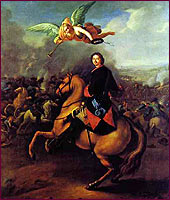 If
Peter was not sleeping, traveling, feasting, or inspecting,
he was busy making something. When he was young and still inexperienced
he could never be shown over a factory or workshop without trying
his hand at whatever work was in progress. He found it impossible
to remain a mere spectator, particularly if he saw something
new going on. If
Peter was not sleeping, traveling, feasting, or inspecting,
he was busy making something. When he was young and still inexperienced
he could never be shown over a factory or workshop without trying
his hand at whatever work was in progress. He found it impossible
to remain a mere spectator, particularly if he saw something
new going on.
|
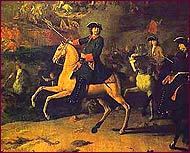 His
favorite occupation was shipbuilding, and no affairs of state
could detain him if there was an opportunity to work on the
wharves. He was such a competent marine architect that his contemporaries
said that he was the best shipwright in Russia, since he not
only could design a ship, but knew every detail of its construction.
Peter took a particular pride in this ability and he stinted
neither money nor effort in extending and improving Russia's
shipbuilding industry. His
favorite occupation was shipbuilding, and no affairs of state
could detain him if there was an opportunity to work on the
wharves. He was such a competent marine architect that his contemporaries
said that he was the best shipwright in Russia, since he not
only could design a ship, but knew every detail of its construction.
Peter took a particular pride in this ability and he stinted
neither money nor effort in extending and improving Russia's
shipbuilding industry.
After his death, it was found that nearly every place
in which he had lived for any length of time was full of the
model boats, chairs, crockery, and snuff-boxes he had made himself.
It is surprising that Peter ever found enough leisure to make
so many things. |
Peter generated considerable opposition during his reign,
not only from the conservative clergy but also from the nobility,
who were understandably rather attached to the status quo. His
reforms were not always popular. Some of them led to revolts
which Peter the Great had to suppress.
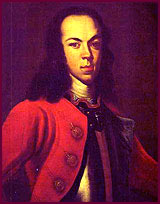 One of the most notable critics of his policies was his
own son Alexis, who naturally enough became the focus of oppositional
intrigue.
One of the most notable critics of his policies was his
own son Alexis, who naturally enough became the focus of oppositional
intrigue.
In fact, Alexis seemed to desire no such position, and in 1716
he fled to Vienna after renouncing his right to the succession.
Having never had much occasion to trust in others, Peter suspected
that Alexis had in fact fled in order to rally foreign backing.
After persuading him to return, Peter had his son arrested and
tried for treason. In 1718 he was sentenced to death, but died
before the execution from wounds sustained during torture.
|

Peter the Great decided that the ruler should nominate
his successor. The tsarship would no longer be a hereditary
position
However, Peter died without nominating an heir and at
his death the question of ascension to the throne was left unanswered.
There was no obvious choice either, as Peter had been married
twice and had 11 children, many of whom died in infancy and
the eldest son from his first marriage, Tzarevich Alexei died
from torture.
Peter himself died in 1725. Unlike previous monarchs,
he was not afraid of physical labour. In November 1724, he dived
into the cold northern ocean to assist in a ship rescue. It
led to his illness and death.
Peter the Great still remains one of the most controversial
figures in Russian history.
|
More than in any other period of Russian
history, the end of the seventeenth and beginning of the eighteenth
centuries was an era of great events and changes for which a
single man was mostly responsible.
Peter the Great's reign transformed Russia. He strengthened
the rule of the tsar and westernized Russia while at the same
time making Russia a power in Europe and greatly expanding Russia's
borders. During his reign, Russia became an empire and Peter
became the first emperor of Russia.
|
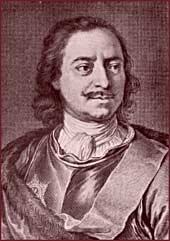 It
is difficult to evaluate Peter's work. By his energy and ruthlessness
he modernized Russia to the extent that it was strong enough
to escape the fate of Poland and the Ottoman Empire, but the
deeper aspects of Western culture never penetrated below the
aristocracy, and the masses of the Russian people were forced
down lower than ever. They remained in ignorance, now separated
culturally as well as economically and socially from their superiors. It
is difficult to evaluate Peter's work. By his energy and ruthlessness
he modernized Russia to the extent that it was strong enough
to escape the fate of Poland and the Ottoman Empire, but the
deeper aspects of Western culture never penetrated below the
aristocracy, and the masses of the Russian people were forced
down lower than ever. They remained in ignorance, now separated
culturally as well as economically and socially from their superiors.
Although he was deeply committed to making Russia a powerful
new member of modern Europe, it is questionable whether his
reforms resulted in significant improvements to the lives of
his subjects.
After Peter's death Russia went through a great number
of rulers in a distressingly short time, none of whom had much
of an opportunity to leave a lasting impression. |
|


